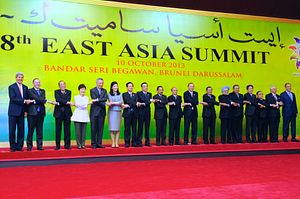The 2014 APEC summit is over, but many of the world leaders leaving Beijing are not heading home. Instead, ASEAN leaders, U.S. President Barack Obama, and Japanese Prime Minister Shinzo Abe are heading to Naypyitaw, Myanmar for a series of meetings involving ASEAN, including the ASEAN Plus Three summit and the East Asia Summit. Chinese Premier Li Keqiang will be attending on Beijing’s behalf.
The APEC summit provided a platform for China to display its vision for the Asia-Pacific: an integrated economic community where Chinese growth is the major driver for prosperity (and thus Chinese interests must be respected). Ironically, however, China may face the most resistance toward its “Asia-Pacific Dream” from its immediate neighbors – particularly ASEAN members that have testy territorial disputes with China.
Reuters reports that the South China Sea issue is likely to be a major topic of discussion at the various ASEAN summits, much to China’s chagrin. Beijing prefers to handle these issues bilaterally, rather than through larger, multilateral bodies. ASEAN secretary-general Le Luong Minh expressed concern over “a widening gap between the political commitments and the actual actions, the real situation at sea.” Even non-claimants are concerned that the tensions are dangerous – Singapore’s foreign affairs minister K Shanmugam said the disputes are one of the biggest threats to regional security, Reuters said.
Indonesia, the de facto leader of ASEAN, has been pushing for a unified approach to the dispute among the ASEAN members. A recent push for a code of conduct in the South China Sea has made little progress, a topic that is likely to come up during the ASEAN-China summit as well as the East Asia Summit.
China and ASEAN have rather optimistically labeled the ten year period beginning in 2014 a “diamond decade” for China-ASEAN relations, which is a high priority for Beijing’s neighborhood diplomacy. Xinhua touts Li’s visit to Myanmar as the beginning of this “new phase for China-ASEAN cooperation.” While China has devoted more diplomatic energy than ever before to its “march West,” its neighbors to the south remain crucial to ensuring Chinese security and national interests in the Asia-Pacific region. Simply put, China’s vision for the Asia-Pacific cannot be realized without cooperation from the 10 Southeast Asian states.
In particular, China needs buy-in from Southeast Asia on its Maritime Silk Road, the maritime complement to the Silk Road Economic Belt. While the land-based route has made considerable progress, with willing partners in Central Asia and beyond, the maritime road remains more nebulous, in part because of concerns from China’s neighbors. It’s hard for China to pitch increased maritime cooperation to neighbors that feel threatened by China’s rapidly expanding navy and coast guard.
In Southeast Asia, Indonesia and Myanmar have joined on, but progress with Vietnam has been slower (despite the inclusion of Hanoi on an official Chinese map of the planned route). If tensions over maritime disputes continue, Southeast Asia could wind up as the “missing link” in China’s Maritime Silk Road. With India also uncertain about joining the initiative, the Maritime Silk Road could be in danger of sinking should ASEAN members shy away.
At the same time, though, the Southeast Asian states have proven eager to accept Chinese investments and develop assistance. Of the 10 ASEAN members, nine have officially joined China’s new Asian Infrastructure Investment Bank. The lone hold-out, Indonesia, is expected to join soon, once new president Joko Widodo’s administration has had time to review the proposal. The AIIB is to be a major mechanism for funding infrastructure development ties to China’s twin Silk Road proposals; the willingness of all of ASEAN (including Vietnam and the Philippines) to join is a positive sign for the Maritime Silk Road.
Still, the South China Sea remains a potential spoiler for the China-ASEAN relationship. Premier Li is well aware of this; in a commentary for the Jakarta Post Li said that the maritime disputes “should not affect regional stability or overall China-ASEAN relations.” He added that China is “fully confident that as long as we stick to the right track, maintain the momentum of dialogue and consultation and strengthen practical maritime cooperation, we will be able to handle the South China Sea issue properly.” Li said that ASEAN and China have reached consensus of a “dual track approach,” wherein the issues involved in specific disputes are discussed bilaterally but ASEAN as a whole is given a role to play in upholding “peace and stability.”
If China can indeed work with ASEAN as a bloc to ensure peace and stability in the South China Sea (with a code of conduct to guide disputants’ actions as the first step), it will go a long way toward helping ease tensions between China and its Southeast Asian nations. The territorial disputes will not be solved any time soon, but they shouldn’t be allowed to poison cooperation between China and ASEAN, particularly given China’s emphasis on a holistic vision for the entire Asia-Pacific region.

































